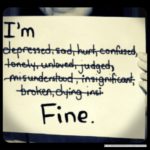
Suicide, the ripple effect
Suicide has an across the board and unfavorable impact on the survivors abandoned. The misfortune experienced by numerous suicide survivors is so significant they may never be able to accept the loss. According to the Center for Disease Control and Prevention (CDC) “suicide was the 10th leading cause of death for all ages in 2013. Suicide was the second leading cause of death among persons aged 15-24 years, the second among persons aged 25-34 years.” There was an average of 105 suicides per day nationally. In Minnesota, suicide is the second leading cause of death for ages 10 through 24. These statistics indicate that suicide is a leading causing death for younger populations in our society. Persons aged 24 through 34 are considered prime ages in our culture. Loses at these ages are significantly harder to accept than someone dying at a later stage in life. Suicidal ideation and gestures are understood as conveying a profound need for connection and attachment. These individuals are reaching out with implicit or sometimes explicit messages of rejection and abandonment. Their messages are also comprised of statements of removing themselves so not to further burden their loved one’s lives. Since they view themselves as a burden they further disengage and distance themselves socially rather than increase intimacy and closeness. These beliefs compound the feelings of abandonment and helplessness held by the individual considering suicide.
When a loved one dies by suicide a ripple event takes place among the estranged family and friends. The grief experienced from the suicide event is compounded with grief from the perceived loss of other relationships and attachment injuries. The complex nature of circumstances surrounding death by suicide puts the survivors at greater risk for physical and mental health problems than people bereaved through other causes of death. Survivors embark on an irreversible journey which changes their internal processes, schemas of the world, and daily interactions and behaviors, both inside and outside of their families. The bereaved contemplate perceived mistakes and lack of effort in preventing the suicide. They feel like they could have done more to prevent the loss. This results in internalized messages of shame, guilt, and a crisis of faith. People of faith wonder how God or their higher power could let this happen. These internalized messages need to be addressed for survivors to move forward without impaired functioning. It should also be noted that people do not “commit suicide”, they die by suicide. The word commit implies a wrong doing which increases the shame and stigma surrounding the loss. Dying by suicide does not follow the same principles as committing murder, crimes or sin. Survivors of suicide are desperate for reasons to hope. We need not shame them, nor their deceased loved ones. The difference may seem semantic and small but is very significant in its practice.
Therapists working with this population need to recognize the role of internalized messages, map the effects of such messages, and provide interventions to reduce the messages and the shame associated with the suicide. Once shame, guilt, and the crisis of faith are tended to, the therapist can work to allow relatives to improve communication. Supportive communication among family members is to replace the messages of blame towards each other. Therapists who can provide compassion and comfort in their consultation can influence a greater facilitation of healing.
References
Hunt, Q. A., & Hertlein, K. M. (2015). Conceptualizing Suicide Bereavement From an Attachment Lens. American Journal Of Family Therapy, 43(1), 16-27. doi:10.1080/01926187.2014.975651









